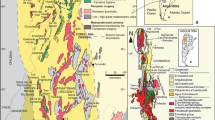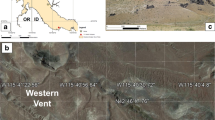Abstract
The Yampa and Elkhead Mountains volcanic fields were erupted into sediment-filled fault basins during Miocene crustal extension in NW Colorado. Post-Miocene uplift and erosion has exposed alkali basalt lavas, pyroclastic deposits, volcanic necks and dykes which record hydrovolcanic and strombolian phenomena at different erosion depths. The occurrence of these different phenomena was related to the degree of lithification of the rocks through which the magmas rose. Hydrovolcanic interactions only occurred where rising basaltic magma encountered wet, porous, non-lithified sediments of the 600 m thick Miocene Brown's Park Formation. The interactions were fuelled by groundwater in these sediments: there was probably no standing surface water. Dykes intruded into the sediments have pillowed sides, and local swirled inclusions of sediment that were injected while fluidized in steam from heated pore water. Volcanic necks in the sediments consist of basaltic tuff, sediment blocks and separated grains derived from the sediments, lithic blocks (mostly derived from a conglomerate forming the local base of the Brown's Park Formation), and dykes composed of disaggregated sediment. The necks are cut by contemporaneous basalt dykes. Hydrovolcanic pyroclastic deposits formed tuff cones up to 100 m thick consisting of bedded air-fall, pyroclastic surge, and massive, poorly sorted deposits (MPSDs). All these contain sub-equal volumes of basaltic tuff and disaggregated sediment grains from the Brown's Park Formation. Possible explosive and effusive modes of formation for the MPSDs are discussed. Contemporaneous strombolian scoria deposits overlie lithified Cretaceous sedimentary rocks or thick basalt lavas. Volcanic necks intruded into the Cretaceous rocks consist of basalt clasts (some with spindle-shape), lithic clasts, and megacrysts derived from the magma, and are cut by basalt dykes. Rarely, strombolian deposits are interbedded with hydrovolcanic pyroclastic deposits, recording changes in eruption behaviour during one eruption. The hydrovolcanic eruptions occurred by interaction of magma with groundwater in the Brown's Park sediments. The explosive interactions disaggregated the sediment. Such direct digestion of sediment by the magma in the vents would probably not have released enough water to maintain a water/magma mass ratio sufficient for hydrovolcanic explosions to produce the tuff cones. Probably, additional water (perhaps 76% of the total) was derived by flow through the permeable sediments (especially the basal conglomerate to the formation), and into the vents.
Similar content being viewed by others
References
Blake DH, Elwell RWD, Gibson IL, Skelhorn RR, Walker GPL (1965) Some relationships resulting from the intimate association of acid and basic magmas. Q J Geol Soc London 121:31–49
Buffler RT (1967) The Brown's Park Formation and its relationship to the late Tertiary geologic history of the Elkhead region, northwestern Colorada — south central Wyoming. Ph. D. thesis, University of California, Berkeley
Cas RAF, Wright JV (1987) Volcanic successions modern and ancient. Allen and Unwin, London, pp 1–528
Christensen AL (1942) Igneous geology of the Elkhead Mountains, Colorado. Ph. D. thesis, University of California
Delaney PT, Pollard DD (1981) Deformation of host rocks and flow of magma during growth of minette dikes and breccia-bearing intrusions near Ship Rock, New Mexico. US Geol Surv Prof Pap 1202:1–61
Fisher RV (1977) Erosion by volcanic base-surge density currents: U-shaped channels. Geol Soc Am Bull 88:1287–1297
Fisher RV, Schmincke H-U (1984) Pyroclastic rocks. Springer, Berlin Heidelberg New York Tokyo, pp 1–472
Fisher RV, Schmincke H-U, van Bogaard P (1983) Origin and emplacement of a pyroclastic flow and surge unit at Laacher See, Germany. J Volcanol Geotherm Res 17:375–392
Forsyth IH, Chisholm MA (1977) The geology of East Fife. Mem Geol Surv GB, HMSO, Edinburgh, pp 1–284
Francis EH (1970) Bedding in Scottish (Fifeshire) tuff-pipes and its relevance to maars and calderas. Bull Volcanol 34:697–712
Frazetta G, La Volpe L, Sheridan MF (1983) Evolution of the Fossa cone, Volcano. J Volcanol Geotherm Res 17:329–360
Heiken GH (1971) Tuff rings: examples from Fort Rock-Christmas Lake Valley basin, south-central Oregon. J Geophys Res 76:5615–5626
Heiken G, Wohletz K (1985) Volcanic ash. University of California Press, Berkeley, pp 1–246
Houghton BF, Hackett WR (1984) Strombolian and phreato-magmatic deposits of Ohakune craters, Ruapehu, New Zealand: a complex interaction between external water and rising basaltic magma. J Volcanol Geotherm Res 21:207–231
Houghton BF, Schmincke H-U (1986) Mixed depositions of simultaneous strombolian and phreatomagmatic volcanism: Rothenberg volcano, East Eifel volcanic field. J Volcanol Geotherm Res 30:117–130
Izett GA (1975) Late Cenozoic sedimentation and deformation in northern Colorado and adjoining areas. Geol Soc Am Mem 144:179–209
Janda RJ, Scott KM, Nolan M, Martinson HA (1981) Lahar Movement, effects, and deposits. In: Lipman PW, Mullineaux DR (eds) The 1980 eruptions of Mount St Helens, Washington. US Geol Surv Prof Pap 1250:461–478
Kienle J, Kyle PR, Self S, Motyka RJ, Lorenz V (1980) Ukinrek maars, Alaska, I. April 1977 eruption sequence, petrology and tectonic setting. J Volcanol Geotherm Res 7:11–37
Kokelaar BP (1982) Fluidization of wet sediments during the emplacement and cooling of various igneous bodies. J Geol Soc London 139:21–33
Kokelaar BP (1983) The mechanism of surtseyan volcanism. J Geol Soc London 140:939–944
Kokelaar P (1986) Magma-water interactions in subaqueous and emergent basaltic volcanism. Bull Volcanol 48:275–289
Kucera RE (1962) Geology of the Yampa district, northwest Colorado. Ph D Thesis, University of Colorado, Boulder
Larson EE, Ozima M, Bradley WC (1975) Late Cenozoic basic volcanism in northwestern Colorado and its implications concerning tectonism and the origin of the Colorado River system. Geol Soc Am Mem 144:155–178
Leat PT, Thompson RN, Morrison MA, Hendry GL, Dickin AP (1988) Compositionally-diverse Miocene-Recent magmatism in NW Colorado: partial melting, and mixing of mafic magmas from 3 different asthenospheric and lithospheric mantle sources. In: Menzies MA, Cox KG (eds) Oceanic and Continental lithosphere: similarities and differences. J Petrol Spec Publ (in press)
Leys CA (1983) Volcanic and sedimentary processes during formation of the Seafell tuff-ring, Iceland. Trans R Soc Edinburgh: Earth Sci 74:15–22
Lorenz V (1984) Explosive volcanism of the west Eifel volcanic field, Germany. In: Kornprobst J (ed) Kimberlites I: kimberlites and related rocks. Elsevier, Amsterdam 299–307
Lorenz V (1985) Maars and diatremes of phreatomagmatic origin: a review. Trans Geol Soc S Afr 88:459–470
Love JD, Christiansen AC (dy1985) Geologic map of Wyoming. US Geol Surv Map (1:500 000)
Lowe DR, Williams SN, Leigh H, Connor CB, Gemmell JB, Stoiber RE (1986) Lahars initiated by the 13 November 1985 eruption of Nevado del Ruiz, Colombia. Nature 324:51–53
Marvin RF, Young EJ, Mehnert HH, Naeser CW (1974) Summary of radiometric age determinations of Mesozoic and Cenozoic igneous rocks and uranium and base metal deposits in Colorado. Isochron/West 11
McGetchin TR, Settle M, Chovet BA (1974) Cinder cone growth modeled after Northeast Crater, Mount Etna, Sicily. J Geophys Res 79:3257–3272
Rowley PD, Kuntz MA, MacLeod NS (1981) Pyroclastic-flow deposits. In: Lipman PW, Mullineaux DR (eds) The 1980 eruptions of Mount St Helens, Washington. US Geol Surv Prof. Pap 1250:489–512
Schmincke H-U, Fisher RV, Waters AC (1973) Antidune and chute and pool structures in the base surge deposits of the Laacher See area, Germany. Sedimentology 20:553–574
Segerstrom K, Young EJ (1972) General geology of Hahns Peak and Farwell Mountain quadrangles, Routt Country, Colorado. US Geol Surv Bull 1349:1–60
Self S, Kienle J, Huot JP (1980) Ukinrek maars, Alaska, II. Deposits and formation of the 1977 craters. J Volcanol Geotherm Res 7:39–65
Sheridan MF, Wohletz KH (1981) Hydrovolcanic explosions: the systematics of water-pyroclast equilibration. Science 212:1387–1389
Sheridan MF, Wohletz KH (1983) Hydrovolcanism: basic considerations and review. J Volcanol Geotherm Res 17:1–29
Snyder GL (1980) Geologic map of the northernmost Park Range and southernmost Sierra Madre, Jackson and Routt counties, Colorado. US Geol Surv Map I-1113 (1:48 000)
Sparks RSJ, Wilson L, Hulme G (1978) Theoretical modeling of the generation, movement, and emplacement of pyroclastic flows by column collapse. J Geophys Res 83:1727–1739
Tweto O (1976) Geologic map of the Craig 1° × 2° quadrangle, northwestern Colorado. US Geol Surv Map I-972 (1:250 000: reprint 1981)
Tweto O (1979a) The Rio Grande rift system in Colorado. In: Riecker RE (ed) Rio Grande rift: tectonics and magmatism. Am Geophys Union, Washington DC, 33–56
Tweto O (1979b) Geological map of Colorado. US Geol Surv Map (1:500 000)
Verwoerd WJ, Chevallier L (1987) Contrasting types of surtseyan tuff cones on Marion and Prince Edward islands, southwest Indian Ocean. Bull Volcanol 49:399–417
Walker BH, Francis EH (1987) High-level emplacement of an olivine-dolerite sill into Namurian sediments near Cardenden, Fife. Trans R Soc Edinburgh: Earth Sci 77:295–307
Walker GPL (1984) Characteristics of dune-bedded pyroclastic surge bedsets. J Volcanol Geotherm Res 20:281–296
Walker GPL (1985) Origin of coarse lithic breccias near ignimbrite source vents. J Volcanol Geotherm Res 25:157–171
Walker GPL, Self S, Wilson L (1984) Tarawera 1886, New Zealand — a basaltic plinian fissure eruption. J Volcanol Geotherm Res 21:61–78
Waters AC, Fisher RV (1971) Base surges and their deposits: Capelinhos and Taal volcanoes. J Geophys Res 76:5596–5614
Williams H (1936) Pliocene volcanoes of the Navajo-Hopi country. Geol Soc Am Bull 47:111–172
Wilson L, Head JW (1981) Ascent and eruption of basaltic magma on the Earth and Moon. J Geophys Res 86:2971–3001
Wohletz KH (1986) Explosive magma-water interactions: thermodynamics, explosion mechanisms, and field studies. Bull Volcanol 48:245–264
Wohletz KH, McQueen RG (1984) Experimental studies of hydromagmatic volcanism. In: Explosive volcanism: Inception, evolution and hazards. Studies in geophysics, National Academy Press, Washington DC, pp 158–169
Wohletz KH, Sheridan MF (1983) Hydrovolcanic explosions II. Evolution of basaltic tuff rings and tuff cones. Am J Sci 283:385–413
Author information
Authors and Affiliations
Rights and permissions
About this article
Cite this article
Leat, P.T., Thompson, R.N. Miocene hydrovolcanism in NW Colorado, USA, fuelled by explosive mixing of basic magma and wet unconsolidated sediment. Bull Volcanol 50, 229–243 (1988). https://doi.org/10.1007/BF01047486
Received:
Accepted:
Issue Date:
DOI: https://doi.org/10.1007/BF01047486




